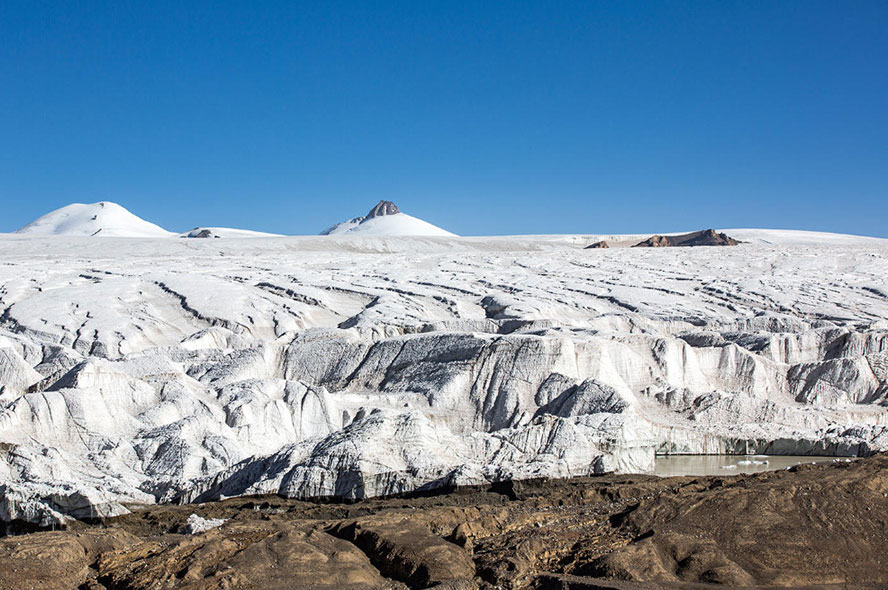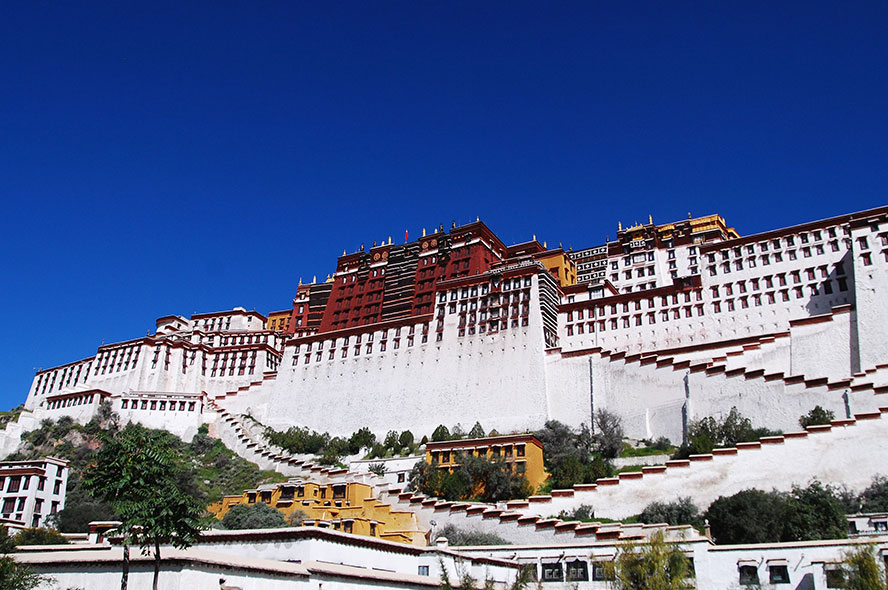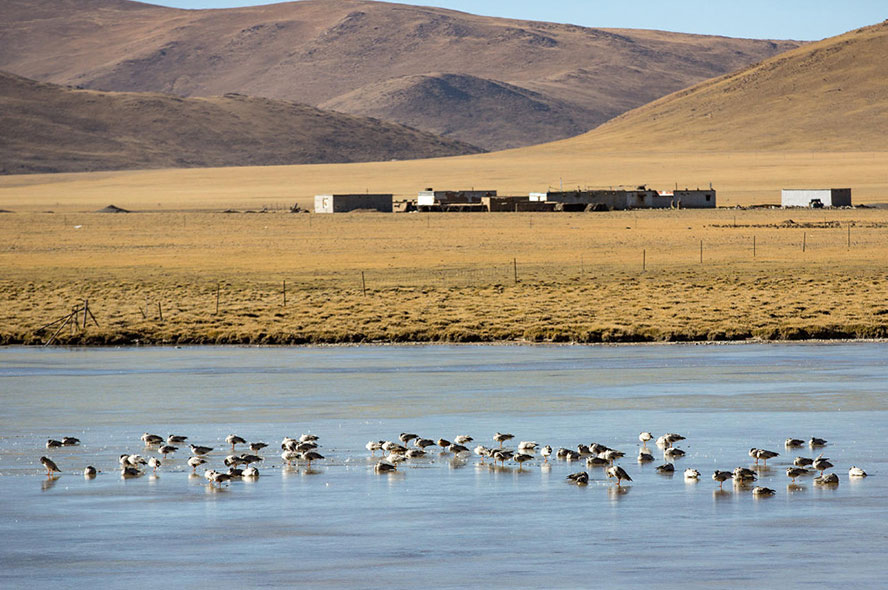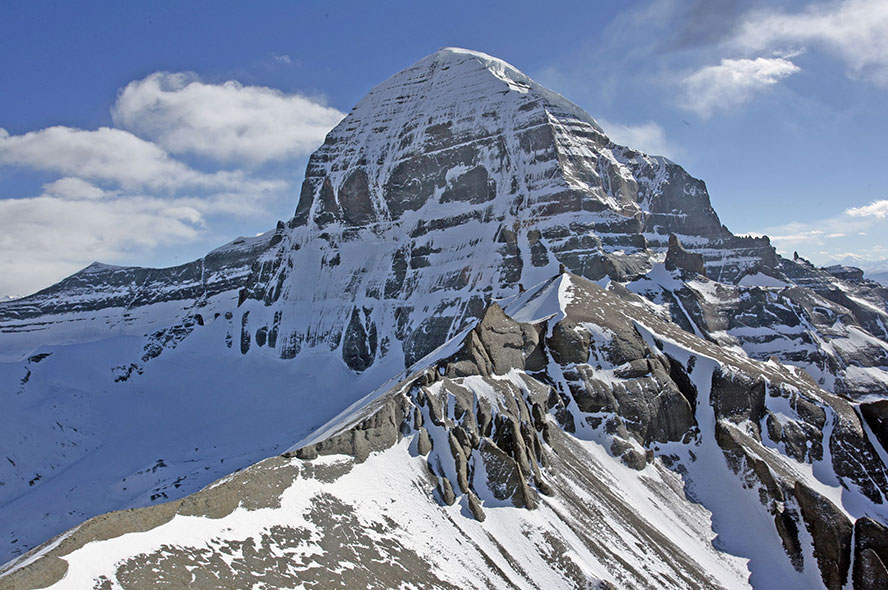The Lanzhou-Lhasa Railway is popular as a train route to Tibet for a number of reasons:
Firstly, Lanzhou was once an important hub of the ancient Silk Road, and it is also the starting point of today’s Lanzhou-Lianyungang Railway. Most of the railways heading for Tibet will make stops in Lanzhou. Therefore, tourists don’t have to worry about the train tickets if they go to Lhasa from Lanzhou.
Secondly, it the only takes 24 hours to take trains from Lanzhou to Lhasa, but tourists are able to enjoy the beautiful scenery along the way and experience four seasons within 24 hours while taking the trains.
Thirdly, Lanzhou itself is a city worth visiting. It is located in the upper reaches of the Yellow River, surrounded by mountains to the north and the south. With the Yellow River passing through the city, the traffic of Lanzhou is very convenient. Ever since the ancient times, Lanzhou has been famous for its eight landscapes: the waterfalls of Wuquan Mountain, the misty rain in Lanshan Mountain, the multi-floored White Pagoda, the pear blossoms in Longweishan Mountain, the morning bells of ancient temples, the far view from the Wanghe Tower, the spring scenery of the Woqiao Bridge, and the moonlit nights in the Xiaoxihu Park. In addition to the eight landscapes, there are also a lot of other attractions worth visiting in Lanzhou, such as the ancient sculptures in the Yanbinhe Road, the Baita Mountain Park, and Waterwheel Park, the Office of the 18 G.A. of the National Revolutionary Army, and the Gansu Provincial Museum, etc. Because of the Yellow River, Lanzhou has also become a city known as “the city of fruits”. Its melons, peaches, and pears of different species are so popular both at home and abroad that people often say that "enjoy the scenery in Hangzhou, and taste the fruits in Lanzhou". In a word, this is a beautiful city which is not far away from Lhasa. Even though its customs and atmosphere are very different from those of Tibetan areas, the city is definitely worth a visit.
Therefore, it is a good choice to go to Lhasa from Lanzhou. There are the detailed guides about the Lanzhou-Lhasa Railway as follows.
Required Documents for Ticket Purchase
1. According to the real-name system of train ticket purchase, people who buys train tickets from mainland China, needs to provide valid documents such as the second-generation ID card, passport or other documents that can prove his/her identity. What’s more, for those who buy train tickets to Tibet, they are required to provide Tibet Travel Permit.
2. For Hong Kong and Macao compatriot who holds his/her valid "Mainland Travel Permit for Hong Kong and Macao Residents ", he/she doesn’t need to apply for Tibet Travel Permit. He / She can take the trains to get to Tibet directly just like the mainland compatriots.
Notes for Applying for Certificates and Purchasing Tickets
1. Since taking trains to Tibet is very popular and buying train tickets in the peak season is rather difficult, we suggest that you submit the information to apply for documents like Tibet Travel Permit as early as possible, so that your travel plans wouldn't be affected.
2.If tourist attractions such as Shigatse, Everest Base Camp, and the holy mountains and lakes in Ngari Area are on your travel list, you not only need to apply for the Tibet Travel Permit, but also need to apply for other travel documents such as the border defense certificates. Therefore, we recommend that you tell us about your travel plans as detailed as possible, so that our travel consultants can apply for all the required documents based on your specific travel plans.
3. For more questions about ticket purchase, please feel free to contact us.
How to Get to Lanzhou Railway Station
Lanzhou Railway Station is located in Chengguan District, Lanzhou, Gansu Province along Huochezhan East Road. Since there are many unlicensed vehicles near the railway station, passengers had better take a taxi or bus to their destinations. Taking buses in Lanzhou is relatively safe and people can almost get to anyplace in the city by bus. For a more convenient and efficient trip in Lanzhou, you can check the bus information in advance. The followings are the public transportation information of Lanzhou Railway Station.
Lanzhou-Zhongchuan Inter-City Railway: The Lanzhou-Zhongchuan Inter-City Railway has been put into operation since the end of September 2015. Tourists can transfer among the Lanzhou Railway Station, Lanzhou West Railway Station and Lanzhou Zhongchuan Airport within 40 minutes by taking the trains, which is much faster than driving cars.
Buses: There is a bus stop on the east side of the square of Lanzhou Railway Station. The Lanzhou Coach Terminal is just 100 meters on the north of the square and a taxi lane is on the west of the square. Buses that will make stops at the north side of the square include: Bus No. 1, No. 6, No. 31, No. 110, No. 131, No. 181, No. 601, and K102. Bus No.137 will make stops at Pingliang Road and Bus No. 10 and No. 112 will make stops at Tianshui Road. Other buses that will pass by the railway station include: No. 7, No. 9, No.12, No.16, No. 17, No. 33, No.118, No.124, and No.126.
Metro Line 2: It will be more convenient to get to Lanzhou Railway Station once Metro Line 2 is put into operation (expected to be operated in 2019).
Recommended Packages
1. Clothing
a. Jackets: Jackets are waterproof and breathable, and the beautiful colors will make you look better while taking pictures.
b. Fleece or down jackets: The temperature difference between day and night on the plateau is very large. In some high altitude areas, warm clothes are needed all year round. Fleece jackets are lighter than ordinary sweaters and the prices are not very high. In addition, tourists who go to Tibet in spring, autumn, and winter are recommended to take warm down jackets with them to against the coldness at nights.
c. Other personal clothing: underwear, long trousers, T-shirts, thin coats, sports socks, raincoats, slippers, etc.
d. Hiking shoes: The surfaces of the roads in Tibet are mostly flat, but a pair of suitable shoes will make your trip in Tibet more comfortable, and they can better protect your ankles in long-walking journey. It is not recommended to wear new shoes for a trip to Tibet, as you couldn’t be sure if they fit and they may rub against your heels.
e. Hats, headscarves and sunglasses: Physical sun protection equipment is more effective than any sunscreen.
2. Backpacks and trolley cases
Choose a backpack or trolley case in accordance to your own situation. A small backpack is also recommended, as it can be used to keep important items and documents.
3. Personal hygiene products
Toiletries (quick-drying towel, face towel, wet towel, shampoo, washing powder, toothpaste, toothbrush, facial cleanser, etc.), storage items (storage bag, garbage bag, cosmetic bag, etc.), cosmetics (moisturizing function) and so on.
4. Documents
ID card, Tibet Travel Permit or Mainland Travel Permit for Hong Kong and Macao Residents, passport, etc.
5. Photography equipment
If you are a photography lover, you are recommended to carry a wide-angle lens of 6~22mm and a telephoto lens of 200mm or above. If you want to take pictures of the starry sky in Tibet, you should also bring a super wide-angle lens or a fixed-focus lens. If you are a mobile photography lover, the wide-angle lens that comes with your phone is enough to meet your needs.
6. Drugs and medicines
Plateau Rhodiola (taking in advance of the journey), Gaoyuan’an, American ginseng lozenges (fatigue relief), Nuodikang capsules (fatigue relief), Paracetamol (headache relief), Quick-Acting Heart Reliever, Danshen tablets (for cardiovascular disease), glucose solution, etc.
7. Food
Although there are restaurants and food is supplied on the trains, we suggest that you bring enough food in accordance to your own taste, because the food on the trains is expensive and you may don’t like they flavor of the food. If you think it will be boring while taking the trains, eating cucumber and acidic fruits is a good way to spend the time on the trains. Besides, wearing the slippers of your own can make you feel more comfortable along the train journey.
More Options for Traveling to Tibet from Lanzhou
There may be places that you don't want to miss on the way from Lanzhou to Lhasa. Then you can choose the following transfer plans to enjoy the scenery along the way from Lanzhou to Lhasa.
Lanzhou - Xining - Lhasa
It only takes one hour from Lanzhou to Xining by trains, and the fares are not expensive at all. Xining is the first stop of the Qinghai-Tibet Railway. All the trains heading for Tibet will make stops here, so tourists don’t need to worry about the train tickets. Besides, it is very convenient to go to Qinghai Lake from Xining.
As the largest salt lake in China, Qinghai Lake was once ranked as the first of the five most beautiful lakes in China by China National Geographic, followed by Kanas Lake, Namtso Lake, Changbai Mountain Pool in the Sky, and the West Lake. It is also known as the paradise of birds, showing its own beauty in all seasons: In March and April, a large number of birds migrate here from the south; in May and June, the birds are laying eggs on the grounds and tourists can see flocks of young birds flying here and there; in July and August, rapeseed flowers are blooming everywhere around the lake. Besides, because of the beauty of Qinghai Lake, Asia’s top cycling races are held in Qinghai Lake every year. Time permitted, a journey to Qinghai Lake will definitely make your trip to Lhasa more colorful and interesting.
Introduction to the Stations along the Lanzhou-Lhasa Railway Route
The scenery in Tibet is numerous, and what you care about the most should definitely be the journey along the Qinghai-Tibet Railway (commonly known as “heavenly road” in China). Taking trains and enjoying the scenery along the Qinghai-Tibet Railway are extraordinary experience that can’t be rejected. Every inch of the land in Qinghai-Tibet area is showing its own beauty under the sunshine. If you look at the map, you will find that 9 world-class tourist attractions are located along the Qinghai-Tibet Railway, such as the Qinghai Lake, the Hoh Xil Nature Reserve, the Sanjiangyuan National Nature Reserve, Namtso Lake, and Potala Palace, etc. 23 tourists attractions along the railway are state-leveled, such as the Ta'er Temple, Chaerhan Salt Lake, Yuzhu Peak, Lhasa Ancient City and Barkhor Street. Besides, there are 6 national nature reserves and scenic spots as well as 193 normal tourist attractions along the way. Tourists are able to see five totally different landscapes when the train runs through the Qinghai Lake, Kunlun Mountain, the source of Yangtze River, Qiangtang Grassland, and Nagqu prefecture-level city.
Lanzhou - Xining: After the train departs from Lanzhou Railway Station, scenery along the railway will slowly change as the altitude increases.
Xining Railway Station - Delingha city - Golmud: After arriving in Xining, the train keeps going westward, and you will see the dark blue Qinghai Lake from the front left side. The first thing that comes to your mind when you see the lake might not be its title - the largest salt lake in China, but a sentence - "Qinghai Lake, a tear on the earth." At the end of May, all kinds of birds will fly to the islands around the lake. They fly in the sky, run on the ground, and catch fish from the water, making the whole scenery of Qinghai Lake colorful and lively.
Golmud - Anduo County - Nagqu (all the trains to Tibet begin to supply oxygen to passengers in Golmud): Nanshankou Railway Station is the official starting point for the second phase of the Qinghai-Tibet Railway, and it is just 30 kilometers away from Golmud. When the train keeps running ahead, you will see the first surprise offered by the Gera section of Qinghai-Tibet Railway - the Yuzhu Peak, from which you can unveil this mysterious snowy plateau.
Located at an altitude of 6,178 meters, Yuzhu Peak is the main peak of the eastern section of the Kunlun Mountains, with several snow-capped mountains on both sides. Even in the midsummer, Yuzhu Peak is covered with snow and glaciers, charming and enchanting. Therefore, Yuzhu Peak is famous for its unique landscape - the snowy scenery in June.
If the train passes through Anduo County at nights and if the weather is fine, you are likely to see the starry sky on the plateau, which is totally different from that of other places.
Kunlun Mountain Pass is actually the gateway to Hoh Xil, which was listed among the World Heritage Sites as "the largest and highest plateau in the world" in 2017. On the banks of the Chumar River on the southern edge of depopulated zone of Hoh Xil, if you see an abstract Tibetan antelope-shaped railway station with a sculpture of Tibetan antelope on its platform, it means that the train has entered the mysterious Hoh Xil area.
Hoh Xil means "beautiful girl" in Mongolian. It is one of the main sources of the Yangtze River. Even though there is no barrier around, Hoh Xil is a paradise for wild animals because of the cold weather, strong winds, and high altitude. Rare animals that can barely be seen in other places such as wild yaks, Tibetan antelopes, wild donkeys, white-lipped deer, and brown bears can be seen almost everywhere in Hoh Xil. The section of the Qinghai-Tibet Railway passing through the Hoh Xil National Nature Reserve is about 200 kilometers. If lucky enough, you may be able to see flocks of Tibetan antelopes lingering on the grasslands or by the riversides.
Nagqu - Damxung County - Lhasa: On the way from Nagqu to Lhasa, the train will pass through the Tanglha Railway Station, which is the highest stop of the Qinghai-Tibet Railway and located at an altitude of 5,072 meters. The location of the station’s platform was specially selected by the Ministry of Railways. If passengers look westward from the platform, they can see the highest peak of Tanglha Mountains. There is no staff in the railway station because of its high altitude and severe environment. This is also the place where the Qinghai-Tibet Highway, which follows the Qinghai-Tibet Railway all the way from Xining, separates from the railway.
The next stop is the Cuona Lake, which is the most beautiful stop of the Qinghai-Tibet Railway. Enjoying the scenery of lakes is an activity that can’t and won’t be missed for a trip Tibet. There are more than 1,500 lakes of different sizes on this Tibetan Plateau. Cuona Lake is located in the northern Tibetan grassland. It is one of the seven holy lakes in Tibet and is the highest freshwater lake in the world. The section of the Qinghai-Tibet Railway passing by the lake is about 40 kilometers, and the station is only 20 meters away from the lake. Just like Tanglha Railway Station, the station in Cuona Lake is also unstaffed. Standing on the platform, you can see that the mirror-like lake is reflecting the blue sky and white clouds, and the birds in far distance are playing on the lake. The whole scenery is so peaceful and holy that you don’t want to break the stillness.
Around 90 kilometers from Lhasa, there lies a town called Yangpachen. It is famous for its geothermal heat and hot springs. Yangpachen Town is located in the basin of the Nyenchen Tanglha Mountains in Tibet. Although the basin is surrounded by snow-capped mountains, glaciers and virgin forests, within the middle of the basin are green meadows. The geothermal fields of Yangpachen are always filled with white mist, and huge steam masses generated by the geothermal heat keep rising from the lake, making the place a fairyland.
Getting to Lhasa: Nyenchen Tanglha Mountains are good companions as they will be with you all the way from Yangpachen to Lhasa. After passing through the several tunnels in Yangpachen, the train will pass through Zao’er Peak and cross the Lhasa River Bridge. Then you will see the magnificent Potala Palace ahead to the left of the train. This ancient city with a history of 1300 years is waiting for your exploration. For a better experience in Lhasa, the first thing you should do when you arrival in Lhasa is to take a comfortable rest, so that you can adapt to the local climate and environment. If there is no any physical problems, you may start your trip in Lhasa. As we all know, strenuous exercises are not recommended while travelling in Lhasa. However, there is still one thing that many people will neglect: Don’t take baths on the first day when you get to Lhasa, otherwise you will more likely to get altitude sickness.
Finally, we hope that this guide will be helpful for you, and we wish you a pleasant journey in Tibet.









































 Data in submission...
Data in submission...